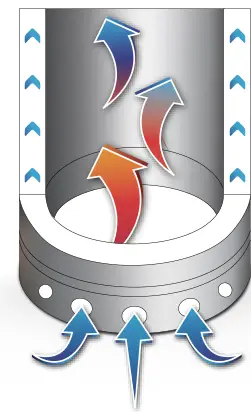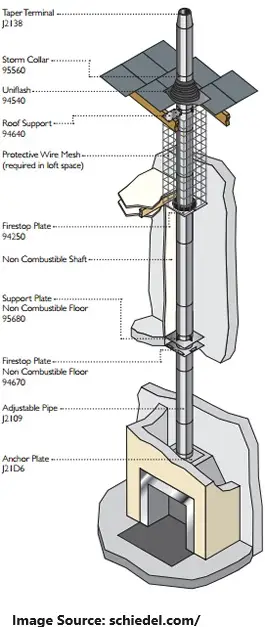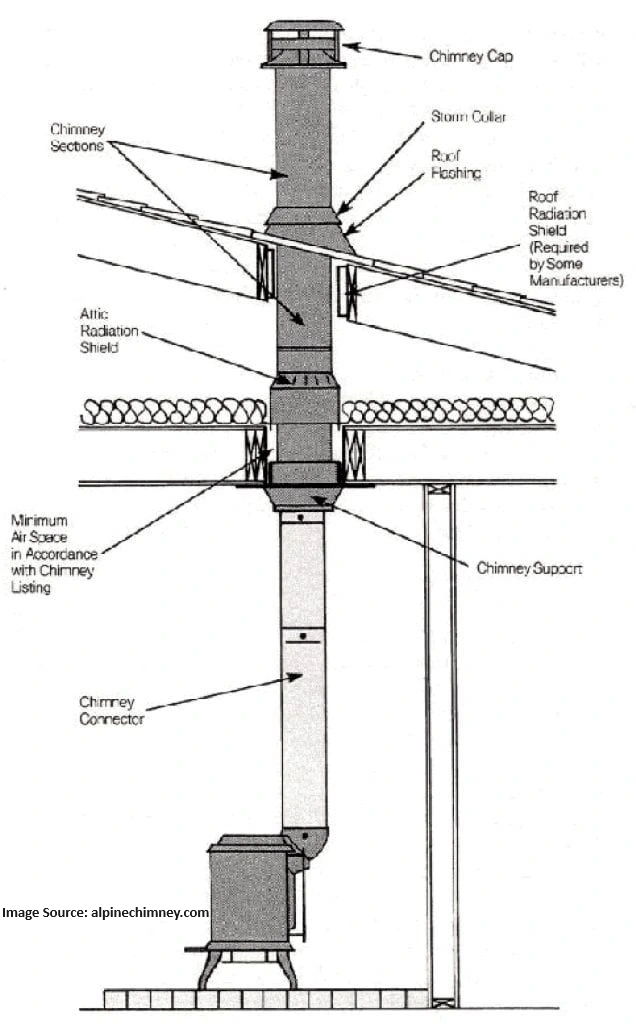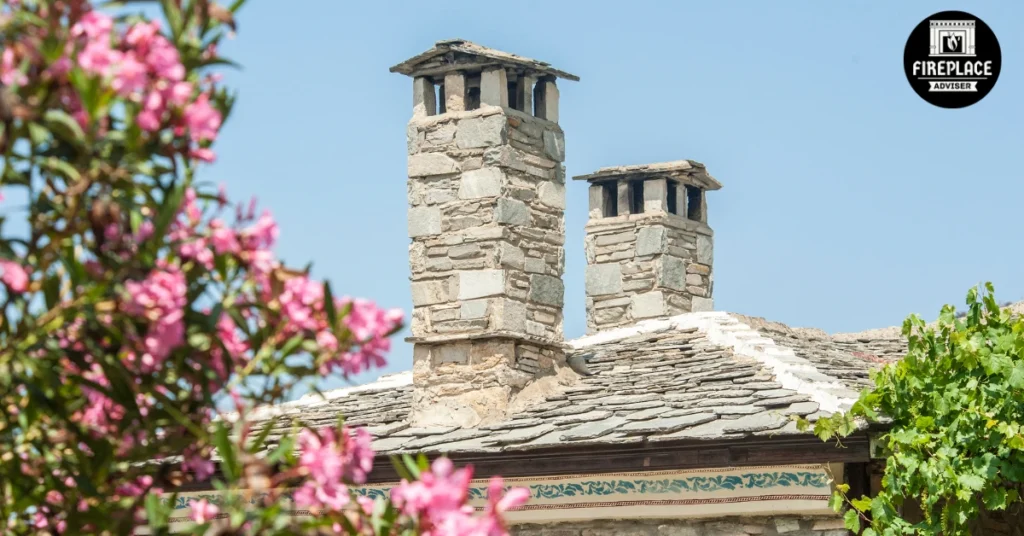When considering the installation of a wood burning fireplace, one of the most critical aspects is understanding wood burning fireplace venting options. Proper venting is essential for safety, efficiency, and maintaining indoor air quality.
Wood burning fireplaces require efficient venting to expel smoke and harmful gases produced during combustion. The venting system you choose will depend on several factors, including the type of fireplace, its location, and your home’s existing infrastructure.
This article explores the best wood burning fireplace venting options, their benefits, and considerations to make when selecting the right system for your home.
Importance of Wood Fireplace Venting
Proper venting of wood burning fireplaces is essential for health, safety, and efficiency. It ensures the safe expulsion of harmful gases like carbon monoxide, preventing indoor air quality issues and reducing the risk of poisoning.
Effective venting enhances combustion efficiency, allowing the fireplace to produce more heat with less wood, ultimately lowering heating costs.
It prevents smoke and unpleasant odors from accumulating indoors, creating a more comfortable living environment.
Compliance with local building codes regarding venting is also crucial for safety and insurance purposes.
Wood Burning Fireplace Venting Options
1. Air-Cooled Chimney System
Air-Cooled Chimney Systems as a wood burning fireplace venting option utilize air for cooling and typically consist of two or three walls with an air gap between them. As the fire burns, warm air rises through the chimney, cooling the outer layers. Air-cooled systems are often used with prefabricated fireplaces.

However, they can be less efficient due to heat loss and are generally larger to accommodate the air space.
Structure and Functionality:
- Inner Flue: This is the primary conduit where smoke and gases travel. It is usually made of stainless steel or other heat-resistant materials to withstand high temperatures.
- Outer Wall: The outer wall is designed to protect the surrounding combustible materials from the heat generated by the flue.
- Air Gap: A critical feature of air-cooled venting systems, the air gap between the inner flue and the outer wall allows air to circulate. As the fire burns, warm air rises through this gap, cooling the outer wall and preventing heat transfer to nearby structures.
- Insulation Layer (Optional): Some air-cooled systems may include an additional insulation layer to further improve safety and efficiency.
Advantages:
- Less expensive to install compared to insulated or masonry chimneys.
- Typically lighter, allowing for simpler installation without extensive structural modifications.
- Compatible with a variety of prefabricated fireplaces, adaptable to different home designs.
- Airflow in the chimney can help minimize creosote accumulation, though regular maintenance is still necessary.
Disadvantages:
- Tendency to lose heat due to the air gap, making them less efficient than insulated options.
- Generally bulkier than insulated chimneys, which can be a concern in space-limited homes.
- Risk of condensation forming inside the chimney, leading to moisture-related issues.
- Inefficiency may be more pronounced in colder regions, potentially increasing heating costs.
2. Insulated Chimney System

Insulated chimneys feature solid insulation between the inner and outer walls, often made from materials like ceramic blankets or fiberglass.
This type of system in wood burning fireplace venting options is more efficient as it retains heat better and minimizes creosote buildup. Insulated chimneys are typically more compact than air-cooled systems and are suitable for both masonry and prefabricated fireplaces
Structure and Insulation Materials:
- Inner Flue: The inner flue, typically made of stainless steel or other heat-resistant materials, serves as the primary conduit for smoke and gases.
- Insulation Layer: A solid insulation layer, often made from materials such as ceramic blankets or fiberglass, is sandwiched between the inner flue and the outer wall. This insulation helps retain heat and prevent heat loss.
- Outer Wall: The outer wall, which can be made of various materials like galvanized steel or aluminum, provides protection and structural support for the insulated system.
Advantages:
- Retains heat better than air-cooled systems.
- Minimizes accumulation of creosote.
- More compact than air-cooled systems.
- Compatible with both masonry and prefabricated fireplaces.
- Maintains outer wall temperature, reducing the risk of heat transfer.
Disadvantages:
- More expensive to purchase and install compared to air-cooled options.
- Installation can be more intricate, requiring careful attention.
- May not be compatible with all types of wood-burning appliances.
- Heavier than air-cooled systems.
- Requires regular maintenance and inspections.
- Improper sizing or installation can lead to overheating issues.
3. Class A Chimney

Class A chimneys are specialized venting systems designed to handle the high temperatures generated by wood-burning appliances, such as stoves and fireplaces with out the need of any masonry .
These chimneys are engineered to provide safe and efficient exhaust of smoke and gases, ensuring that the combustion process does not compromise the safety of the home or its occupants.
Class A chimney pipes feature a double-wall construction, which consists of an inner flue and an outer casing. The inner pipe is typically made of high-temperature stainless steel, while the outer pipe is designed to protect against heat transfer.
The space between the two walls is insulated with one inch of high-quality insulation on all sides. For example, a 6-inch inner pipe will have an 8-inch outer pipe. This insulation plays a crucial role in maintaining optimal temperatures within the flue, enhancing efficiency and safety.
One of the significant advantages of Class A chimneys is their ability to reduce clearance requirements to combustibles.
With proper installation, these chimneys can maintain a clearance of just 2 inches from combustible materials, making them an excellent choice for tight spaces.
Advantages:
- The compact design allows for installation in areas where space is limited, both inside and outside the home.
- Class A chimneys can accommodate a variety of fuel types, providing flexibility for homeowners.
- The insulated double-wall design minimizes the risk of heat transfer to nearby combustibles, enhancing overall safety.
- Compared to masonry chimneys, Class A systems can be more affordable to install and maintain.
Disadvantages:
- High Initial Cost
- Maintenance Costs
- Professional Installation RequiredS
- tructural Modifications Needed
- Space Constraints Due to Clearance Requirements
- Potential Aesthetic Impact
- Heavy Components Add Structural Load
- Regular Cleaning and Inspections Needed
- Exposure to Weather Can Cause Damage
- Risk of Corrosion
- Limited Flexibility in Venting Configurations
4. Stone Masonry Chimney

Stone masonry chimneys are a traditional and durable option for venting wood-burning fireplaces. Constructed from bricks or stones and mortar, these chimneys create a robust air-venting pathway that effectively channels smoke and gases outside.
Stone masonry chimneys are built on-site using non-combustible materials such as bricks, blocks, or natural stones, held together with mortar. This construction method provides a solid and stable structure.
Typically, these chimneys feature square or rectangular terra-cotta flue tiles that line the interior. These tiles help to contain the heat and direct the smoke safely outside.
The chimney design often includes a pyramid-shaped smoke chamber that connects the flue to the firebox, ensuring efficient smoke evacuation.
When properly maintained, stone masonry chimneys can last for hundreds of years, providing a long-term solution for wood-burning fireplace venting.
Advantages:
- Offer a classic and timeless look, enhancing the visual appeal of a home. They can be customized to match the architectural style of the building.
- These chimneys are designed to withstand high temperatures, making them suitable for venting wood-burning fireplaces and stoves.
- With proper maintenance, stone masonry chimneys can provide decades of reliable service, adding significant value to the property.
- The thick walls of stone masonry provide natural insulation, helping to maintain consistent flue temperatures and reducing the risk of creosote buildup.
- Although maintenance is required, stone masonry chimneys are generally less prone to issues like rust or corrosion compared to metal chimneys.
Disadvantages:
- Require more physical space than other venting options.
- Building a stone masonry chimney can be labor-intensive and may require skilled masonry work, leading to higher initial costs.
- Cleaning a masonry chimney can be more difficult compared to metal chimneys, as the interior surfaces may be rough and accumulate soot and creosote.
- Masonry materials can be susceptible to damage from freeze-thaw cycles, moisture infiltration, and other environmental factors, necessitating regular inspections and maintenance.
- The upfront cost for constructing a stone masonry chimney can be significantly higher than for other types of chimneys, such as Class A or air-cooled options.
What is the best Way to Vent a Fireplace?
The best way to vent a wood-burning fireplace is through a vertical chimney that extends above the roofline. This method ensures that smoke and combustion gases are expelled high above the home, reducing the risk of backdrafts and improving safety.
Can you Side Vent a Wood-Burning Fireplace?
Yes, you can side vent a wood-burning fireplace, but there are important considerations to ensure safety and compliance with building codes. Horizontal venting is possible, typically requiring a vent pipe that extends horizontally through an exterior wall and then rises vertically at least 5 feet to properly expel smoke and gases.
This configuration must adhere to local regulations regarding clearances from combustible materials and the type of venting system used.
Affiliate Disclosure: Fireplaceadviser.com is a participant in the Amazon Services LLC Associates Program. We may earn a commission when you click on certain links on this site and purchase.

Hello!! I am Jamal Khan. I often fix my home electric heaters and gas stove problems and research the common issues in the heating units to improve my knowledge and expertise. The aim of establishing fireplaceadviser.com is to share my expertise and knowledge with my audience.












